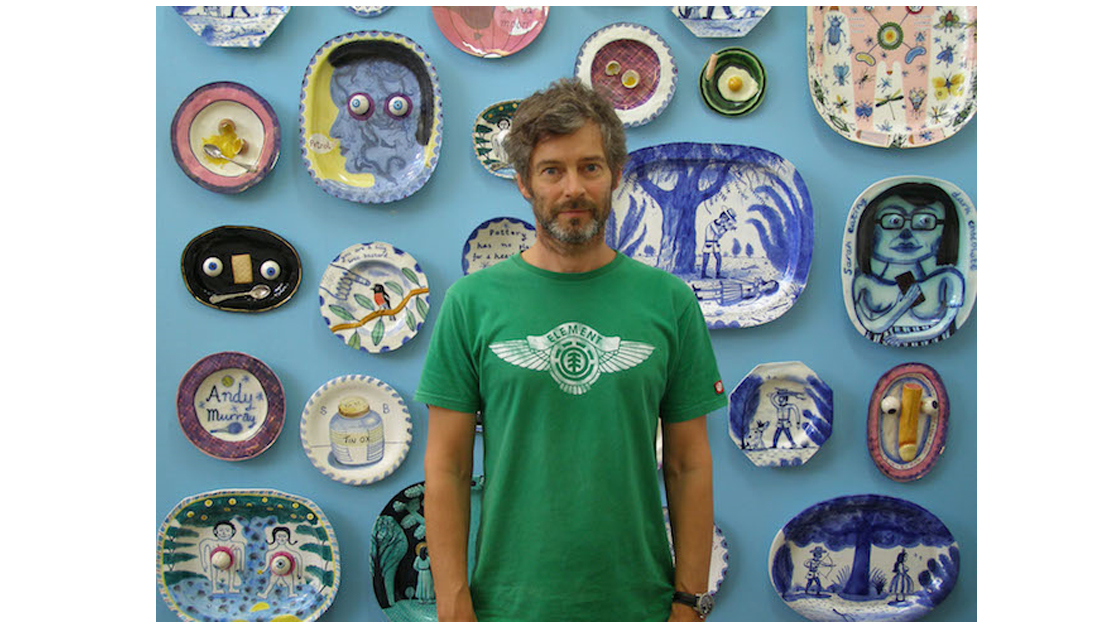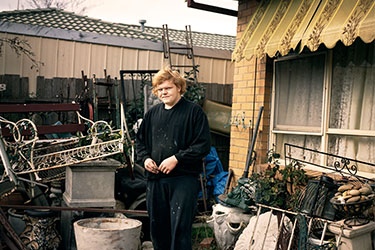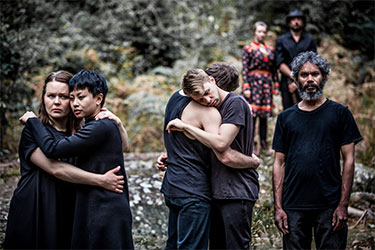Stephen Bird Wins Gold Coast International Ceramic Art Award
Congratulations to Stephen Bird, winner of the 30th Gold Coast International Ceramic Art Award, awarded by Judge Glenn Barkley. Bird, an artist and teacher at the National Art School noted his different approach with his winning work, "The works are two sculptures that I made in when I was in Korea. They differ a little bit from my normal work because I was using some very different clays and glazes. I didn’t have access to moulds I would normally use to press mould sections so they are very handmade, very hands on and very much experimental works". Barkley acknowledged Bird's lasting influence and contribution to ceramics, stating, "Stephen’s work for a long time has been a touchstone for younger artists and as if to demonstrate in this show there is an abundance of handmade, cast or found works which in some way have a familial link to Stephen’s practice."
In Issue 19 he was interviewed by Lesley Chow about his dark and whimsical practice that leads the mind to stray...
Stephen Bird’s works are naïve at first glance, troubling close up. The British-born ceramicist creates decorative plates spattered with gore; candy dishes which sprout eyes instead of sweets. Human heads are piled like stacks of glazed buns. We are invited to covet these body parts as delicious treats.
Bird is interested in playing with myths of murder and sexuality. Several of his pretty arrangements are, in fact, depictions of crime scenes. ‘Where the wild roses grow’, references both a lover and a killer. In one work Bird recreates the relationship in the duet by singers Nick Cave and Kylie Minogue in which a murderer stands over a female corpse. Yet the overall effect of this piece is pleasing, even delightful. The victim’s flowered smock merges with the lawn, while a flowing brook encircles the scene. Bird invents grisly narratives surrounded by sweet details: rabbits, pastoral vistas and the traditions of English crockery.
You have a particular fondness for decapitated heads: your works feature heads swimming in a dish, pillars made of heads.
It’s a matter of taking things that look wrong and using them to construct a work. To me heads are building blocks, like Lego, in the way they sit together. With heads that are severed, it’s my way of reflecting on a violent society, in which beheading is the ultimate insult.
English fairytales often have severed heads as trophies or oracles. Are ghoulish fairytales an influence on your work?
Yes, there are a lot of children’s rhymes about cutting one’s head off. But I’m not the kind of artist who researches one particular area to make one series of works. I do research all the time, but it tends to be very varied research, lots of stories accrued over a long period of time. When people look at my works featuring a gun and an apple tree, they ask me: is it about William Tell? Or William Burroughs? Or is it Isaac Newton, with the apple falling from the tree? It could be about any of them.
A number of pieces feature multiple heads: for instance, a double-headed figure jammed into a teapot shape.
I was creating a figure called the Staffordshire Psycho, a kind of ogre related to the killer in American Psycho. I did these works a couple of years ago for the ‘Collect’ show at Saatchi Gallery. At the time all the news in the UK was so grim, financially and in terms of climate. I wanted to take the traditional Staffordshire ceramics and alter them to reflect this austerity period in the UK.
There are these super-creatures, seen in Boxers (2010) and Dreamy do (2009), whose bodies contain bundles of heads.
They are meant to be heroic figures in classical poses, like Greek statues. They’re in movement but it’s not full baroque movement. Those figures are made up of everyday objects I have in my studio. I’m intrigued by boxing – it became popular because it was a sport that could be watched by both peasants and gentlemen. It’s a form of controlled violence that is a hangover from blood sports.
In your recent work, there has been a focus on eyes. Eye pie (2011), for example, is a latticework pastry studded with eyeballs instead of cherries.
There are many recurring myths involving eyes, from Oedipus to King Lear. These are characters who have no insight until they lose their sight, so it’s about gaining insight.
There is a history of body parts being tarted up to look appetising. In Shakespeare’s Titus Andronicus, a character is tricked into eating a pie with human parts baked into it.
That is kind of like a children’s rhyme, isn’t it? Like having four-and-twenty blackbirds baked in a pie. Ceramics have a long tradition of being used for eating, so I like toying with that idea to create a kind of culinary effect and some strange taste combinations.
Where does the idea of eating human body parts come from?
After I left college I had a Turkish artist friend in Dundee whose restaurant was a meeting place for like-minded artists at a formative time. He had children just before I did. You know how people often say to little children, “I could eat you all up”? He said that he could actually feel it; he really did feel like he could eat his son. I thought it was a strange sensation and couldn’t understand it then. But there is something about the smell of your children that is just delicious, in a way that people who don’t have children can’t really understand. I think there are a lot of feelings that we repress from consciousness, and I want to re-examine some of them.
What attracts you about myths of violence?
I am interested in objects that depict violence and why they were made. In 2007 I did a residency at the Potteries Museum in
Stoke-on-Trent [in England]. They had all these strange ceramic pieces. There was a piece I assumed to be a cuddly teddy bear holding a baby bear. The baby bear turned out to be a Staffordshire bull terrier that was used for bear-baiting. In the 18th century bears would be taken to villages where people would bring their dogs to attack
them. I’m fascinated by the history of blood sports – these acts of violence from our past.
Your images of sex and violence are often filled out with picturesque elements, such as bunnies in a meadow.
I think you need both sweetness and goriness to bring up the contrast. That’s the nature of making beautiful ceramic objects.
If they were made in a different medium, such as bronze, it
wouldn’t work. Bronze is such a horrible colour and traditionally associated with serious subjects. But with ceramics there is something really seductive about the surface, so you get pulled
into a work and it’s not until you get close that you realise what you’re looking at.
What does it mean to attack the sacred through ceramics, as opposed to painting? Do we expect ceramic art to be more sober, less satirical?
You can get away with a lot in ceramics. When people come to dinner at my house and see these pink lustre plates on the walls, it can be 20 minutes before they register that they’re looking at scenes of oral sex.
Your attitudes to love and religion are quite distinctive. There are a number of distorted religious icons here, including a glitzy Bondi Jesus and a Christ-like figure receiving oral sex.
I think we’re quite used to mocking our deities and seeing deeds done to Jesus. I went to a Church of England boarding school; my uncle and my father-in-law were priests. I guess I feel I’ve got every right to mock my own background.
I notice that any work featuring lovers or Adam and Eve tends to be lewd. The male and female bodies are splayed, and their faces are expressionless.
I’ve taken classical figures like lovers and butchered them to bring them up to date. We’re so used to seeing images of couples with fig leaves. I wanted to depict them more graphically and realistically.
How did you come to settle on ceramics as your main practice after an established career in painting?
Construction was a big theme when I was painting at art college: gluing things onto the canvas, building it up, nailing bits of wood together and then painting them. Ceramics is a bit like deconstructed painting. For painting, manufacturers have taken raw materials and transformed them into colours. But in ceramics you’re actually working with the raw materials and developing the colours yourself through the firing process. I’ve always been interested in doing sculpture and painting together, and that’s exactly what ceramics is. It’s the perfect blend, because you can paint and sculpt at the same time.
EXHIBITION
Gold Coast International Ceramic Art Award
27 August 2016 – 23 October 2016
Gold Coast City Gallery
Stephen Bird is represented by Gould Galleries, Melbourne, and Olsen Irwin Gallery, Sydney.
www.gouldgalleries.com
www.olsenirwin.com
www.stephenbird.net
Courtesy the artist and Olsen Irwin Gallery, Sydney.













